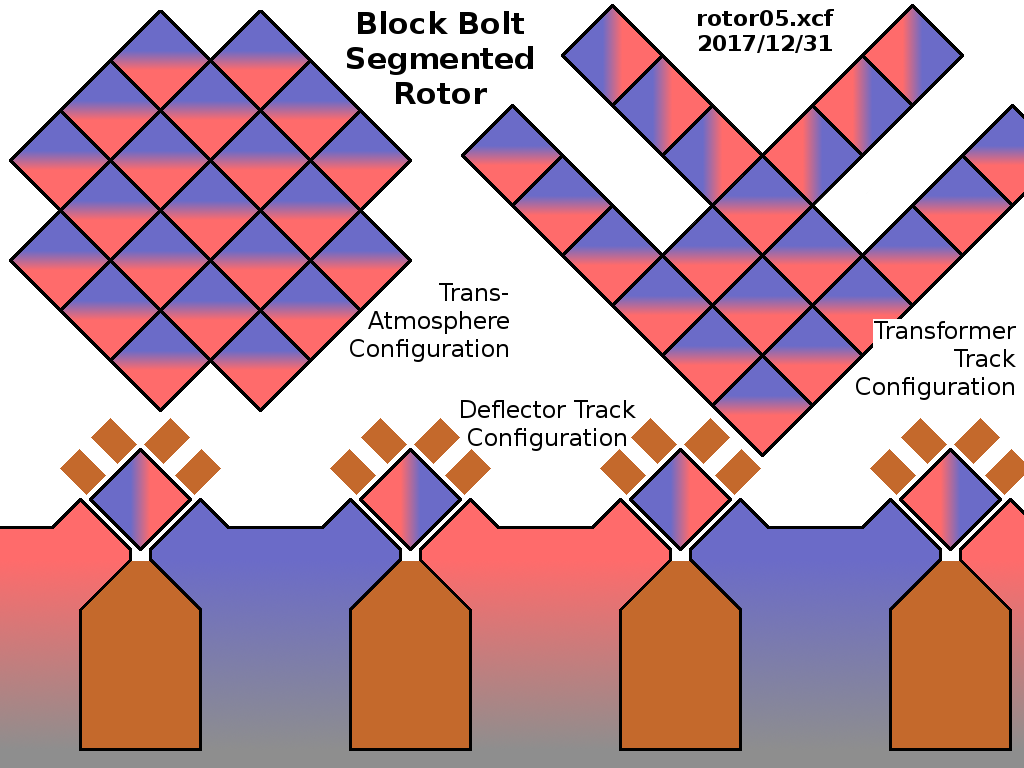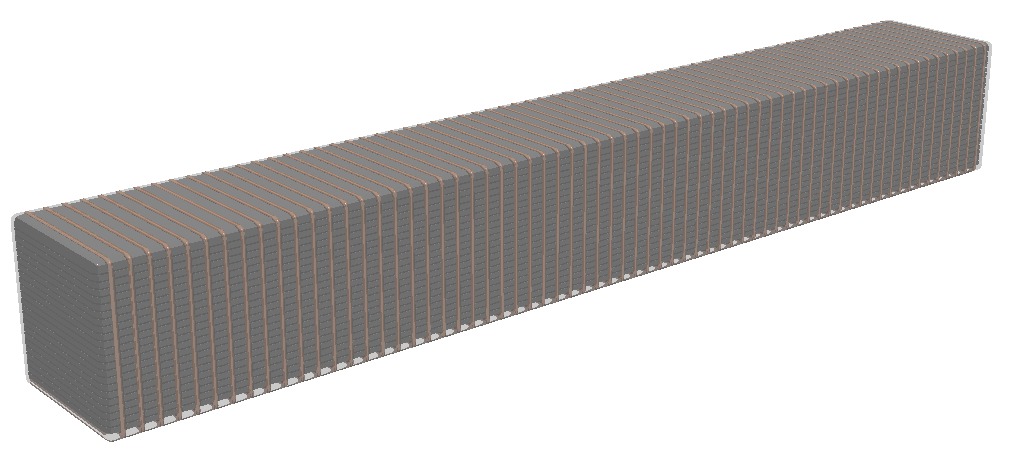|
Size: 2320
Comment:
|
Size: 2329
Comment:
|
| Deletions are marked like this. | Additions are marked like this. |
| Line 3: | Line 3: |
| || {{attachment:rotor05.png | | width=400 }} || The new rotor is composed of "block bolts", 5 millimeter square, perhaps 10 meter long blocks (or square bars) of laminated transformer steel, wrapped in thin aluminum wire hoop motor windings, and coated with amorphous diamond. The brown material around the deflector magnets represents copper coils, either providing the main deflection field (assumed around 2 Tesla) or the distance adjustment magnets opposite the deflection magnets.<<BR>><<BR>>The bolts are spread out for travel around the high radial acceleration deflector magnets, bunched into a minimum cross section for passage up and down narrow tubes for passage through the windy and turbulent atmosphere, and reshaped into a V (or flat H) configuration to act as a velocity transformer rotor on the acceleration path<<BR>><<BR>>[[attachment:rotor05.png | png drawing for download]]|| | || {{attachment:rotor05.png | | width=400 }} || The new rotor is composed of "block bolts", 5 millimeter square, perhaps 10 meter long blocks (or square bars) of laminated transformer steel, wrapped in thin aluminum wire hoop motor windings, and coated with amorphous diamond. The brown material around the deflector magnets represents copper coils, either providing the main deflection field (assumed around 2 Tesla) or the distance adjustment magnets opposite the deflection magnets.<<BR>><<BR>>The bolts are spread out for travel around the high radial acceleration deflector magnets, bunched into a minimum cross section for passage up and down narrow tubes for passage through the windy and turbulent atmosphere, and reshaped into a V (or flat H) configuration to act as a velocity transformer rotor on the acceleration path.<<BR>><<BR>>[[attachment:rotor05.png | png drawing for download]]|| |
| Line 5: | Line 5: |
| The individual streams of bolts are "braided" and "un-braided" as they pass through the system. If there are 21 bolts in parallel, they will follow a "mobius path" so they are positioned in each of the 21 positions consecutively. | Iindividual streams of bolts are "braided" and "un-braided" as they pass through the system. If there are 21 bolts in parallel as shown, they will follow a "mobius path" so they are positioned in each of the 21 positions consecutively. |
| Line 7: | Line 7: |
| All bolts are bar-coded, and the outer bolts are microscopically measured with laser-flash-illuminated ultra-high-speed cameras on every passage of each end; indivual bolt streams will also be imaged on four sides, entering and exiting the D magnets and the turnarounds. Bolts that appear to be damaged are swapped with fresh bolts launched from east return station and accelerated to rotor speed; the damaged bolts are ejected from west return station ... either slowed to fall into the ocean, or launched full speed into Earth escape. | All bolts are bar-coded, and the outer bolts are microscopically measured with laser-flash-illuminated ultra-high-speed cameras on every passage of each end; individual bolt streams will also be imaged on four sides, entering and exiting the D magnets and the turnarounds. Bolts that appear to be damaged are swapped with fresh bolts launched from east return station and accelerated to rotor speed; the damaged bolts are ejected from west return station ... either slowed to fall into the ocean, or launched full speed into Earth escape. |
New Rotor for Launchloop 2.1
|
The new rotor is composed of "block bolts", 5 millimeter square, perhaps 10 meter long blocks (or square bars) of laminated transformer steel, wrapped in thin aluminum wire hoop motor windings, and coated with amorphous diamond. The brown material around the deflector magnets represents copper coils, either providing the main deflection field (assumed around 2 Tesla) or the distance adjustment magnets opposite the deflection magnets. |
Iindividual streams of bolts are "braided" and "un-braided" as they pass through the system. If there are 21 bolts in parallel as shown, they will follow a "mobius path" so they are positioned in each of the 21 positions consecutively.
All bolts are bar-coded, and the outer bolts are microscopically measured with laser-flash-illuminated ultra-high-speed cameras on every passage of each end; individual bolt streams will also be imaged on four sides, entering and exiting the D magnets and the turnarounds. Bolts that appear to be damaged are swapped with fresh bolts launched from east return station and accelerated to rotor speed; the damaged bolts are ejected from west return station ... either slowed to fall into the ocean, or launched full speed into Earth escape.
|
A short version of a block bolt - real bolt blocks will be much longer. Estimated size will be 5 millimeters square, 10 meters long. The gray sheets represent transformer steel, the copper colored hoops around the sheets represent aluminum-carbide-coated aluminum coils (they will be thin and flat in real life) and the transparent coating is amorphous diamond, like the material used to coat tools. . . . . png drawing for download . . . .Povray code for download |


